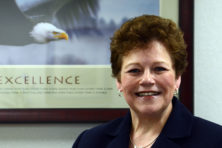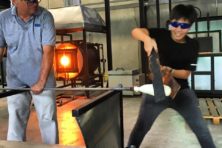Taking GLOBE to Wisconsin Classrooms
- Share
- Tweet
- Pin
- Share

On Earth Day 1995, a multi-agency-supported science and education project began in 33 countries. Today, more than 120 countries take part in the program, and citizen scientists who participate in it have contributed more than 150 million measurements to its database.
The program is known as GLOBE (Global Learning and Observations to Benefit the Environment), and the director of its Wisconsin office, Rosalyn Pertzborn, will be a keynote speaker at the sixth annual Door County Climate Change Forum on May 18 at Stone Harbor Resort in Sturgeon Bay. Her presentation is titled “Advancing Climate Change Literacy in Rural Wisconsin Schools: GLOBE for Citizen Scientists.”
GLOBE is a collaboration among the National Science Foundation, NASA and the National Oceanic and Atmospheric Administration and was created as an international science-education program to bring together students, teachers, citizens and scientists in gathering local environmental data.
Wisconsin became a GLOBE partner in 1996, with Dr. Sanjay Limaye as the original director and Pertzborn as the program coordinator. She has served as director since 2003.
“We work on a regional basis to provide professional-development opportunities for teachers to implement programs in their classrooms,” Pertzborn said.
The teachers then take what they’ve learned into the classroom for hands-on citizen science conducted by students.
“I think the beauty of a program like GLOBE [is that] students have the hands-on opportunities to collect the data, analyze the data, share it with other schools and communities, and understand how scientists reach their conclusions,” Pertzborn said.
She and collaborator Dr. Michael Notaro of the Nelson Institute Center for Climatic Research at UW-Madison, in partnership with the Wisconsin Ice Age Trail Alliance, were able to snag competitive funding for a three-year baseline GLOBE program that began last year.
“Between these three partners,” she said, “over the next several years we will be training teachers north and south of the Curtis Tension Zone: basically a fairly well-defined east-to-west area that crosses Wisconsin – essentially a band that roughly defines the southern deciduous forest from the northern coniferous forest.”
The first weeklong teacher training was held last year in Butternut.
“This particular project is looking at the lower first kilometer of the atmosphere and the impact of vegetative changes from spring through fall,” Pertzborn said. “The Butternut school students and lead teacher are collecting soil data at 19 different areas distributed in a 10-kilometer area. It provides a very well-defined set of data collection for the atmosphere for hydrology, for soil and for biosphere.”
Both teachers and students are energized by the prospect of taking part in real science.
“We try to provide as much support for successful implementation as possible,” she said. “The students love to get outside to collect data. There’s one recurrent theme regarding feedback from teachers regarding response from their students. We use applied mathematics for the data collection. It’s amazing how many teachers come back and tell us the students say, ‘Oh, that’s why we have to learn math.’ Integration of math and science finally makes sense to the students. That’s been a very consistent recurring theme. Some students actually now like math. It becomes a tool they can apply. It’s refreshing to get that feedback from the teachers.”
In addition to her GLOBE duties, Pertzborn is also director of UW-Madison’s Atmospheric, Earth & Space Outreach at the Space and Science Engineering Center. But in a previous life, she was a middle school science and math teacher.
“GLOBE was not around when I taught,” she said. “In all honesty, I would have used this in every class I taught. It is just perfect at that grade level in particular.”
The target for GLOBE is rural schools and students because they often do not have access to the larger variety of opportunities available to metropolitan schools.
“I grew up in a rural community myself, on a farm,” Pertzborn said. “It’s really a joy for me to go back to a community and share what I’ve learned during my many years here at the UW working with scientists.”
Pertzborn said there’s a very good reason for sharing the GLOBE message at the climate-change forum.
“Without a doubt, it’s important for communities to be aware of the types of STEM-education opportunities that are available,” she said. “I think as we look into the future and attempt to better anticipate impacts that climate change will have on our local communities and economies, it’s important that the young people in particular really understand how scientists come to the conclusions they arrive at.”
She advises people to attend the forum with an open mind and questions.
“We love questions,” she said. “And we’d love to see your community in our training the year after next. We’ll be north of the Curtis Tension in 2020. This year we’re south.”
And how to make that happen?
“The school districts are really quite critical,” Pertzborn said. “It’s really critical the school board and community leaders support it.”
This year’s climate change forum is titled Ethics, Culture & Education: A Powerful Response to Climate Change. The event will take place at Stone Harbor Resort; the cost is $30 per person.


